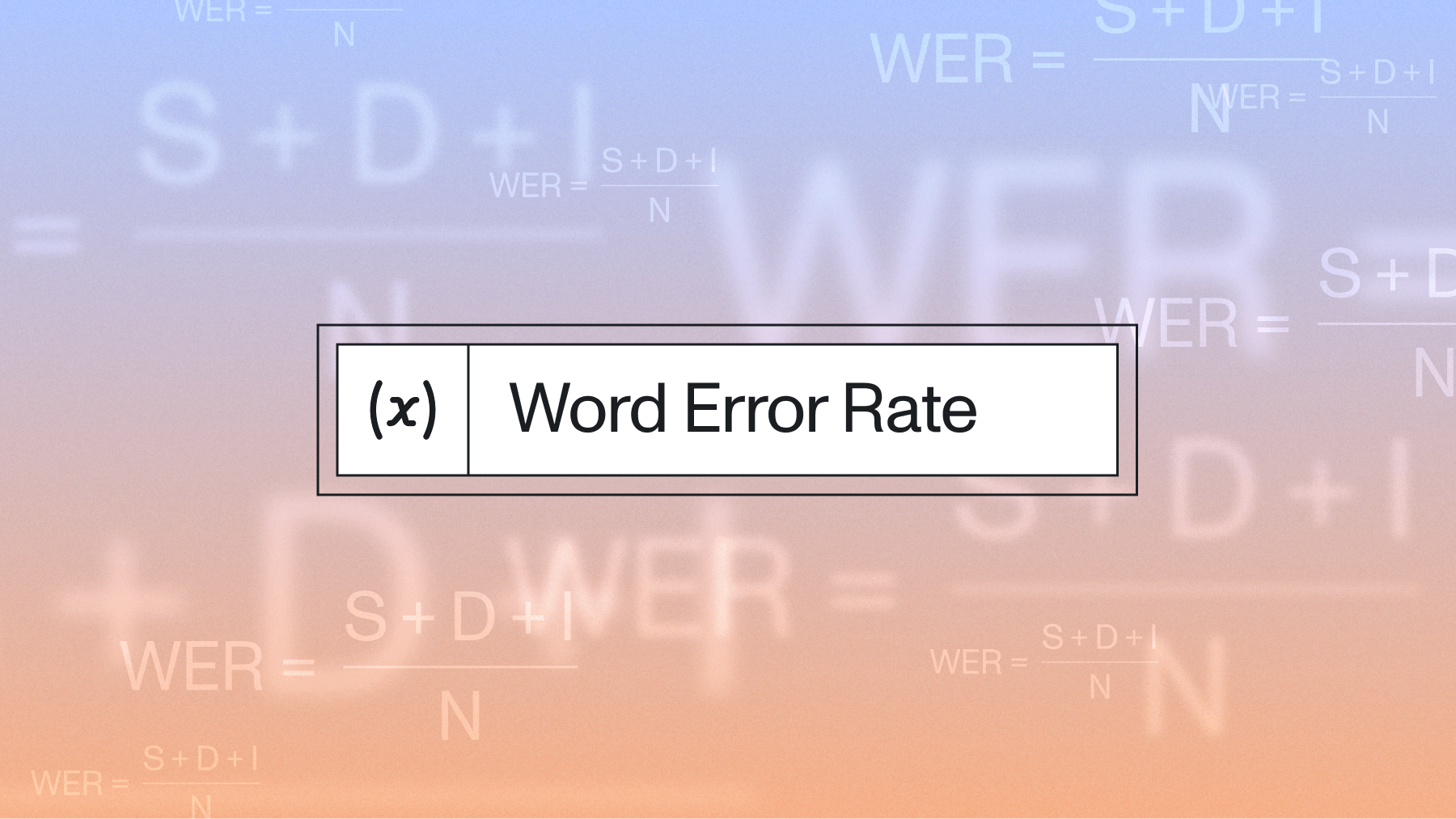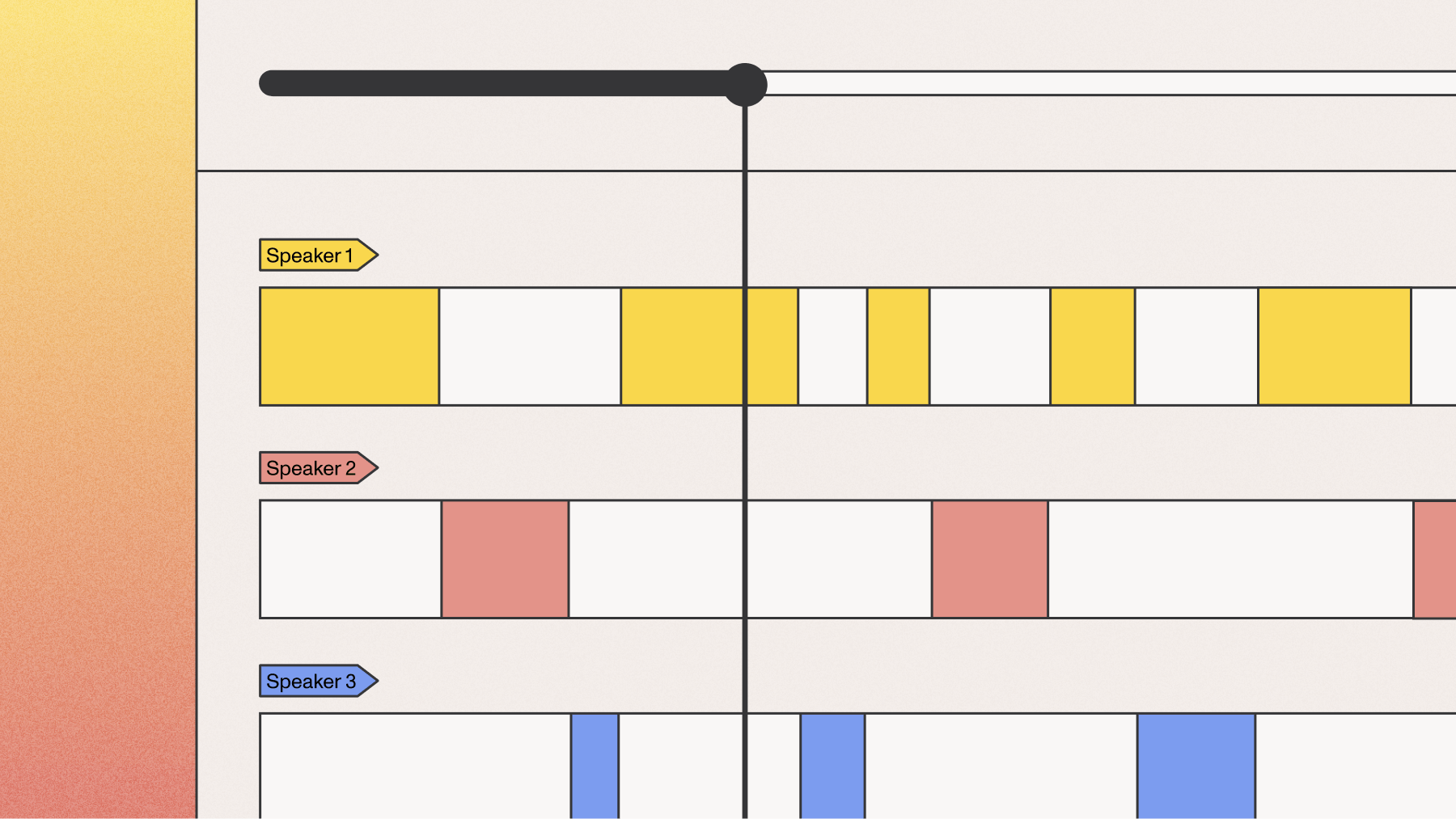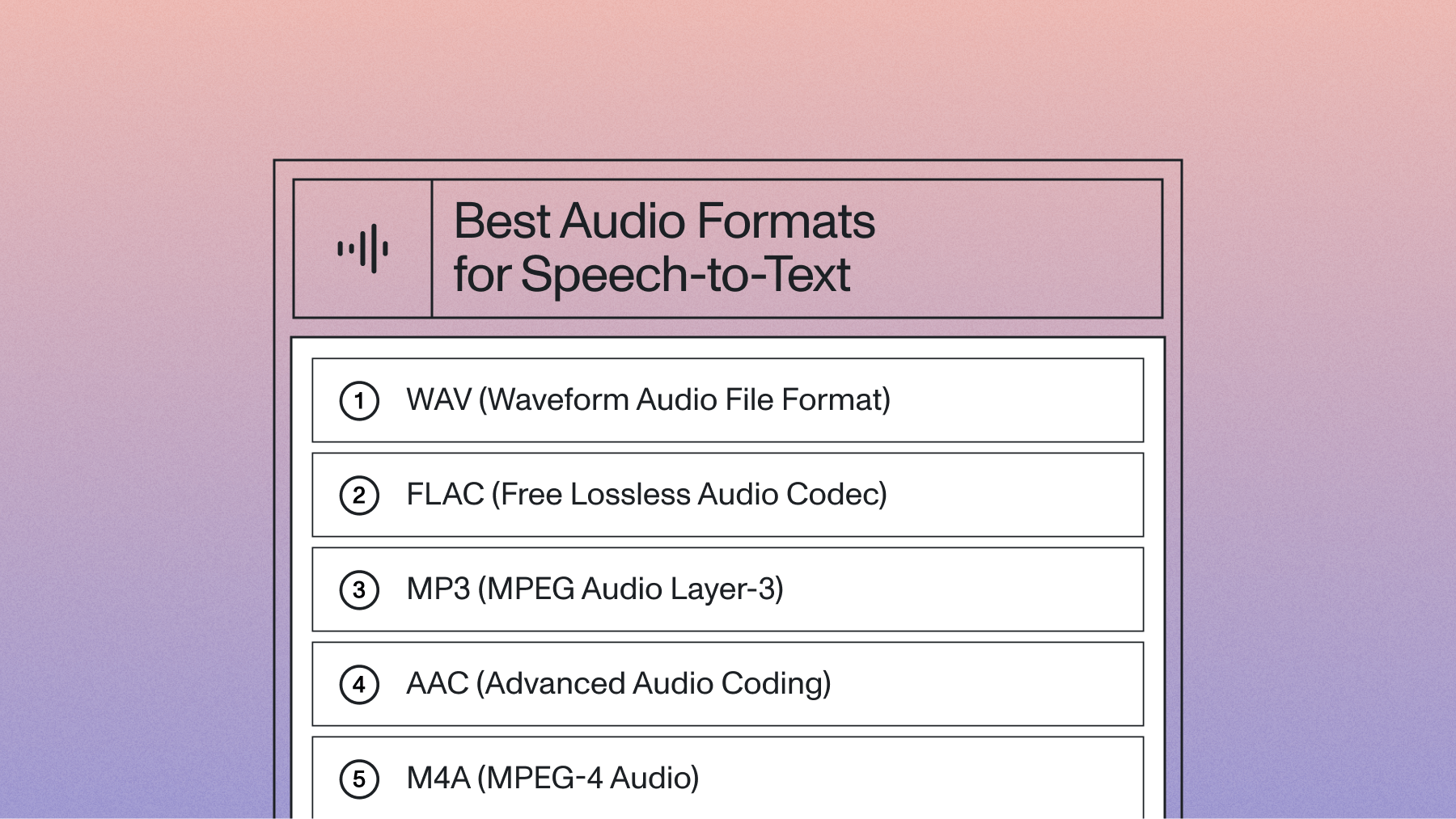Top 8 speaker diarization libraries and APIs in 2025
In this blog post, we'll look at how speaker diarization works, why it's useful, some of its current limitations, and the top eight speaker diarization libraries and APIs for product teams and developers to use.



In its simplest form, speaker diarization answers the question: who spoke when?
In the field of Automatic Speech Recognition (ASR), speaker diarization refers to (A) the number of speakers that can be automatically detected in an audio file, and (B) the words that can be assigned to the correct speaker in that file.
Today, many modern Speech-to-Text APIs and speaker diarization libraries apply advanced AI models to perform tasks (A) and (B) near human-level accuracy, significantly increasing the utility of speaker diarization APIs. Recent advances in 2025 have dramatically improved performance in challenging real-world conditions, with updates like AssemblyAI's new speaker embedding model achieving documented improvements of 30% in noisy environments.
In this blog post, we'll look at how speaker diarization works, why it's useful, some of its current limitations, and the top eight speaker diarization libraries and APIs for product teams and developers to use. We'll examine the different approaches available and help you choose the right solution for your specific needs.
What is speaker diarization?
Speaker diarization answers the question: "Who spoke when?" It involves segmenting and labeling an audio stream by speaker, allowing for a clearer understanding of who is speaking at any given time. This process is essential for automatic speech recognition (ASR), meeting transcription, call center analytics, and more.
Speaker Diarization performs two key functions:
- Speaker Detection: Identifying the number of distinct speakers in an audio file.
- Speaker Attribution: Assigning segments of speech to the correct speaker.
The result is a transcript where each segment of speech is tagged with a speaker label (e.g., "Speaker A," "Speaker B"), making it easy to distinguish between different voices. This improves the readability of transcripts and increases the accuracy of analyses that depend on understanding who said what.
How does speaker diarization work?
The fundamental task of speaker diarization is to apply speaker labels (i.e., "Speaker A," "Speaker B," etc.) to each utterance in the transcription text of an audio/video file.
Accurate speaker diarization requires many steps. The first step is to break the audio file into a set of "utterances." What constitutes an utterance? Generally, utterances are at least a half second to 10 seconds of speech. To illustrate this, let's look at the below examples:
Utterance 1:
Hello my name is Bob.
Utterance 2:
I like cats and live in New York City.
In the same way that a single word wouldn't be enough for a human to identify a speaker without prior knowledge, AI models also need more data to identify speakers too. This is why the first step is to break the audio file into a set of "utterances" that can, later, be assigned to a specific speaker (e.g., "Speaker A" spoke "Utterance 1").
There are many ways to break up an audio/video file into a set of utterances, with one common way being to use silence and punctuation markers. In our research, we start seeing a drop off in a Speaker Diarization model's ability to correctly assign an utterance to a speaker when utterances are less than one second.
Once an audio file is broken into utterances, those utterances get sent through a deep learning model that has been trained to produce "embeddings" that are highly representative of a speaker's characteristics. An embedding is a deep learning model's low-dimensional representation of an input. For example, the image below shows what the embedding of a word looks like:
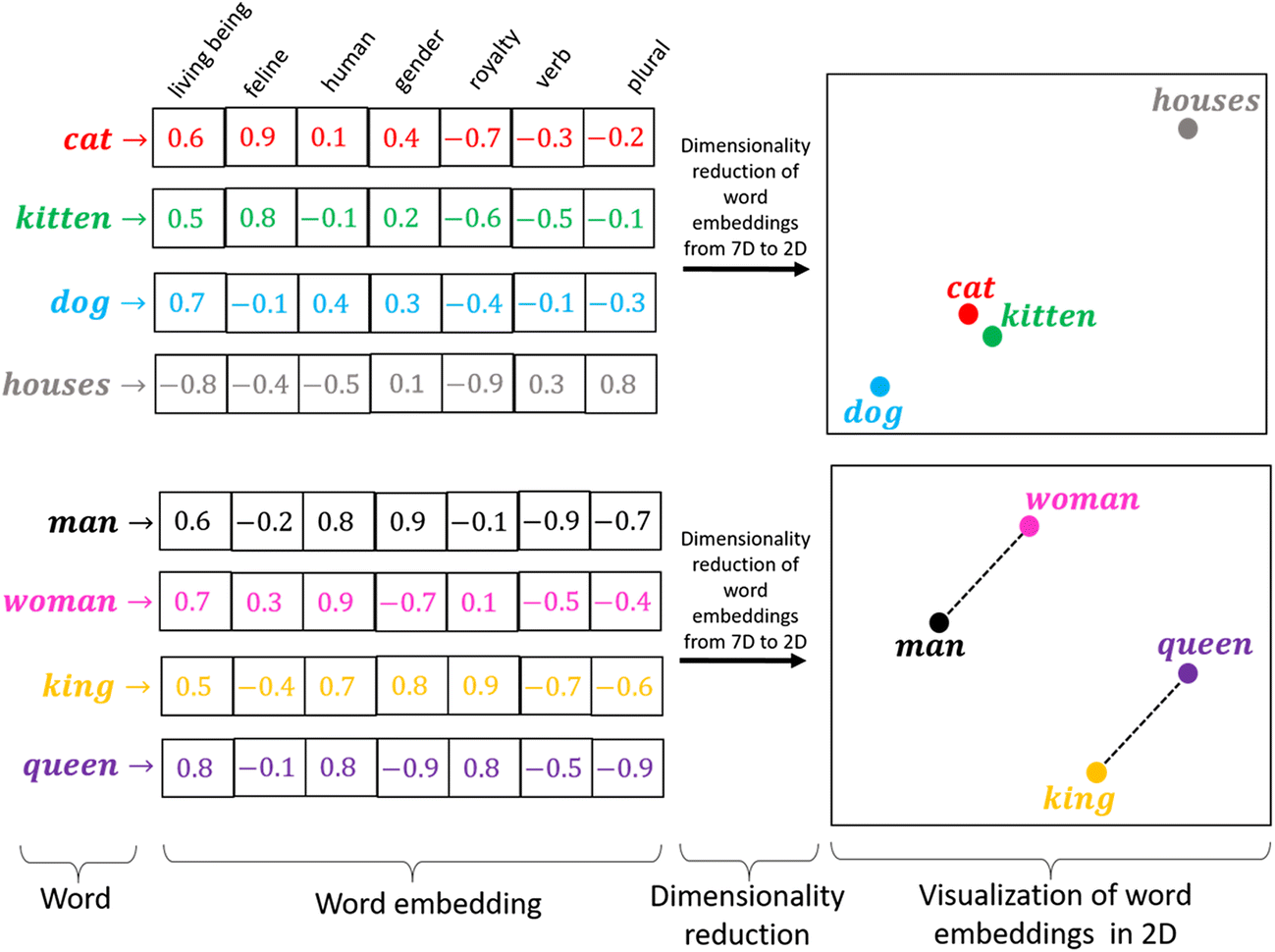
We perform a similar process to convert not words, but segments of audio, into embeddings as well.
Next, we need to determine how many speakers are present in the audio file--this is a key feature of a modern speaker diarization model. Legacy speaker diarization systems required knowing how many speakers were in an audio/video file ahead of time, but a major benefit of modern speaker diarization models is that they can accurately predict this number.
Our first goal here is to overestimate the number of speakers. Using a clustering method, you want to determine the greatest number of speakers that could reasonably be heard in the audio. Why overestimate? It's much easier to combine the utterances of one speaker that has been incorrectly identified as two than it is to disentangle the utterances of two speakers which have incorrectly been combined into one.
After this initial step, we go back and combine speakers, or disentangle speakers, as needed to get an accurate number.
Finally, speaker diarization models take the utterance embeddings (produced above), and cluster them into as many clusters as there are speakers. For example, if a speaker diarization model predicts there are four speakers in an audio file, the embeddings will be forced into four groups based on the "similarity" of the embeddings.
For example, in the below image, let's assume each dot is an utterance. The utterances get clustered together based on their similarity — with the idea being that each cluster corresponds to the utterances of a unique speaker.
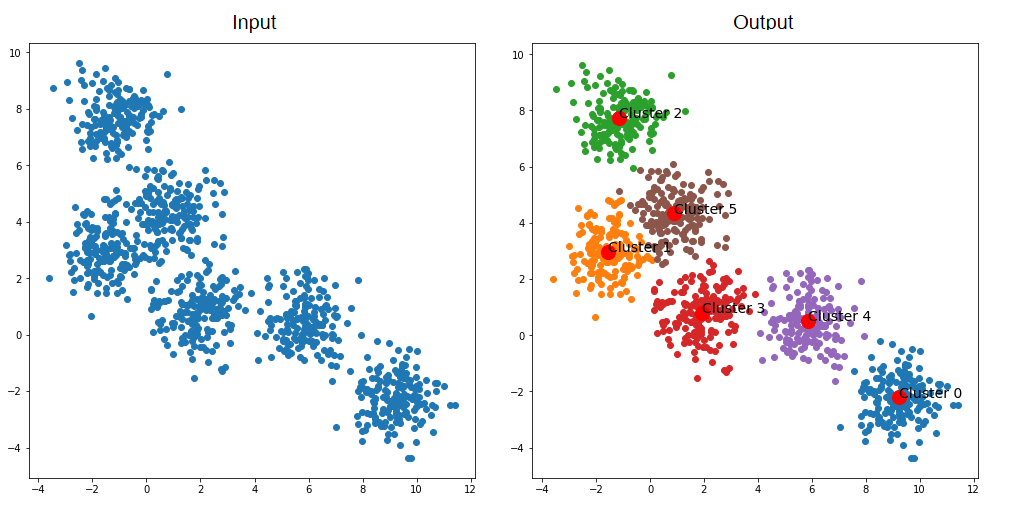
There are many ways to determine similarity of embeddings, and this is a core component of accurately predicting speaker labels with a speaker diarization model. After this step, you now have a transcription complete with accurate speaker labels!
Recent advances have introduced end-to-end approaches that eliminate traditional pipeline stages by treating diarization as a unified problem. These newer architectures can better handle overlapping speech and brief utterances that previously challenged traditional systems.
Today's speaker diarization models can be used to determine multiple speakers in the same audio/video file with high accuracy. It's important to note that speaker diarization differs from speaker recognition — diarization identifies different speakers without knowing their identities, while recognition matches voices to known individuals.
Speaker diarization example process
To illustrate this process, let's consider an example:
- Audio Segmentation: An audio file containing a conversation is segmented into utterances based on pauses and punctuation.
- Feature Extraction: Each utterance is processed by an AI model to create embeddings that represent the unique vocal characteristics of each speaker.
- Clustering: The embeddings are clustered into groups based on the proximity in the embedding space. Each cluster is expected to correspond to one person.
- Speaker Attribution: The utterances within each cluster are labeled with the same speaker tags, and these tags are used to annotate the transcript.
Why is speaker diarization useful?
Speaker diarization is useful because it takes a big wall of text and breaks it into something much more understandable and valuable. If you were to try and read a transcription without speaker labels, your brain would automatically try and assign each word/sentence to the appropriate speaker. Speaker diarization saves you time and mental energy.
For example, let's look at the before and after transcripts below with and without speaker diarization:
Without speaker diarization: [Example of wall of text]
With speaker diarization: [Example with speaker labels]
See how much easier the transcription is to read with speaker diarization?
Speaker diarization is also a powerful analytics tool. By identifying and labeling speakers, product teams and developers can analyze each speaker's behaviors, identify patterns/trends among individual speakers, make predictions, and more. For example:
- A call center might analyze agent/customer calls or customer requests or complaints, to identify trends that could help facilitate better communication.
- A podcast service might use speaker labels to identify the <host> and <guest>, making transcriptions more readable for end users.
- A telemedicine platform might identify <doctor> and <patient> to create an accurate transcript, attach a readable transcript to patient files, or input the transcript into an EHR system.
Enterprises are already leveraging these capabilities to transform their operations and create powerful transcription and analysis tools.
Additional benefits of speaker diarization
Speaker diarization doesn't just make transcripts easier to read—it adds significant value across various applications. Here are some additional benefits:
- Better readability: Clearly identified speakers make transcripts easier to follow, reducing cognitive load and improving comprehension for readers.
- Improved meeting records: In business settings, detailed speaker labels help track contributions, follow up on action items, and guarantee accountability.
- Legal compliance: Accurate identification of speakers in legal proceedings can be critical for maintaining accurate records and guaranteeing all parties are properly represented.
- Enhanced customer insights: In customer service and support, analyzing speaker interactions can reveal insights into customer sentiment, agent performance, and areas for process improvement.
- Training and development: For training purposes, speaker-labeled transcripts can help trainers identify areas where employees may need further development or highlight best practices from top performers.
- Content creation: For media and entertainment, speaker labels make it easier to edit and produce content, as editors can quickly locate and differentiate between speakers.
- Educational use: In educational settings, speaker-labeled transcripts can help students follow along with lectures more easily and review material more effectively.
- Research and analysis: For researchers, being able to distinguish between different speakers can provide deeper insights into conversational dynamics and interaction patterns.
Top 8 speaker diarization libraries and APIs
Choosing the right speaker diarization solution depends on your specific needs: accuracy requirements, processing speed, integration complexity, and whether you need a managed API or open-source flexibility. Here's our comprehensive analysis of the leading solutions:
Let's examine each solution in detail:
1. AssemblyAI
AssemblyAI is a leading speech recognition startup that offers Speech-to-Text transcription with high accuracy, in addition to offering speech understanding features such as sentiment analysis, Topic Detection, summarization, entity detection, and more.
AssemblyAI's speaker diarization has seen dramatic improvements in 2024-2025, achieving a 10.1% improvement in Diarization Error Rate (DER) and 13.2% improvement in cpWER. Based on extensive testing, the service demonstrates 30% better performance in noisy environments and handles speaker segments as short as 250ms with 43% improved accuracy compared to previous versions.
Key improvements:
- Industry-leading 2.9% speaker count error rate (based on internal benchmarking)
- Enhanced handling of similar voices
- Support for 16 languages
- Improved timestamp accuracy through Universal-2 integration
- Pricing: $0.15/hour
Its Universal speech-to-text API includes an option for speaker diarization. Simply enable speaker_labels=true in your API call to access these capabilities at no additional cost.
import requests
import time
base_url = "https://api.assemblyai.com"
headers = {
"authorization": "<YOUR_API_KEY>"
}
with open("./my-audio.mp3", "rb") as f:
response = requests.post(base_url + "/v2/upload",
headers=headers,
data=f)
upload_url = response.json()["upload_url"]
data = {
"audio_url": upload_url, # You can also use a URL to an audio
or video file on the web
"speaker_labels": True
}
url = base_url + "/v2/transcript"
response = requests.post(url, json=data, headers=headers)
transcript_id = response.json()['id']
polling_endpoint = base_url + "/v2/transcript/" + transcript_id
while True:
transcription_result = requests.get(polling_endpoint,
headers=headers).json()
if transcription_result['status'] == 'completed':
print(f"Transcript ID:", transcript_id)
break
elif transcription_result['status'] == 'error':
raise RuntimeError(f"Transcription failed:
{transcription_result['error']}")
else:
time.sleep(3)
for utterance in transcription_result['utterances']:
print(f"Speaker {utterance['speaker']}: {utterance['text']}")
For a complete implementation guide, see our Python speaker diarization tutorial.
2. Deepgram
Deepgram's diarization feature emphasizes processing speed, claiming to process audio 10X faster than the nearest competitor according to their benchmarks. Their latest model shows a 53.1% improvement from their previous version and operates in a language-agnostic manner.
Key features:
- No limit on number of speakers
- Language-agnostic operation
- Focus on processing speed (10X faster per their benchmarks)
- Integrated with their Nova-2 speech recognition model
Deepgram's speed-first approach makes it suitable for applications where rapid processing is the primary requirement.
3. Speechmatics
Speechmatics claims to be 25% ahead of their closest competitor in accuracy according to their benchmarks. They offer speaker diarization through their Flow platform with both cloud and on-premise deployment options.
Key features:
- Enhanced accuracy through punctuation-based corrections
- Configurable maximum speakers (2-20)
- Support for 30+ languages
- Processing time increase of 10-50% when diarization is enabled (per their documentation)
Speechmatics provides deployment flexibility for enterprise environments that require on-premise options or have specific compliance needs.
4. Gladia
Gladia combines Whisper's transcription capabilities with PyAnnote's diarization, providing an integrated solution for developers using Whisper. Their enhanced diarization option includes additional processing for edge cases.
Key features:
- Whisper + PyAnnote integration
- Enhanced diarization mode for challenging audio
- Configurable speaker hints
- Streaming support available
This integration provides a pathway for teams already using Whisper to add speaker diarization capabilities without managing multiple services.
5. PyAnnote
PyAnnote is a widely-used open-source speaker diarization toolkit, now in version 3.1. It achieves approximately 10% DER with optimized configurations on standard benchmarks and processes with a 2.5% real-time factor on GPU.
Recent improvements include better handling of overlapping speech and enhanced speaker embeddings. PyAnnote serves as the foundation for several commercial solutions, including Gladia.
Key considerations:
- Requires training or fine-tuning for optimal performance on specific use cases
- Supports Python 3.7+ on Linux and MacOS
- Requires Hugging Face authentication token for pre-trained model access
- Active research community and regular updates
PyAnnote is well-suited for research projects and teams with ML expertise who need customizable diarization solutions.
6. NVIDIA NeMo
NVIDIA NeMo introduces Sortformer, an end-to-end diarization approach using an 18-layer Transformer architecture. This innovative design eliminates traditional pipeline stages by treating diarization as a unified problem.
Key features:
- End-to-end neural architecture
- Multi-scale diarization decoder (MSDD)
- Seamless ASR integration
- GPU-optimized processing
NeMo's speaker diarization pipeline includes:
- Voice Activity Detector (VAD) for speech detection
- Speaker Embedding Extractor for vocal characteristics
- Clustering Module for speaker grouping
The system supports both oracle VAD (using ground-truth timestamps) and system VAD (using model-generated timestamps). NeMo is designed for researchers and teams building custom multi-speaker ASR systems who have access to GPU resources and ML expertise.
7. Kaldi
Kaldi is a speech recognition toolkit widely used in academic research that includes speaker diarization capabilities. It offers extensive customization options and has been the foundation for many speech processing research projects.
With Kaldi, users can either:
- Train models from scratch with full control over the pipeline
- Use pre-trained X-Vectors network or PLDA backend from the Kaldi website
Getting started with Kaldi requires understanding its unique architecture and recipe-based approach. This Kaldi tutorial provides an introduction to the framework. For speaker diarization specifically, this tutorial covers the implementation details.
Kaldi is best suited for academic research and teams with speech processing expertise who need maximum flexibility and control over their diarization pipeline.
8. SpeechBrain
SpeechBrain is a PyTorch-based toolkit offering over 200 recipes for various speech tasks, including speaker diarization. It provides both pre-trained models and training frameworks for researchers and developers.
Key features:
- Extensive recipe collection covering 20+ speech tasks
- PyTorch-based architecture for easy integration
- Modular design allowing component customization
- Active development community and regular updates
The toolkit includes features like dynamic batching, mixed-precision training, and support for single and multi-GPU training. SpeechBrain aims to bridge research and production by providing structured recipes that can be adapted for specific use cases.
It's particularly suitable for teams familiar with PyTorch who want to experiment with different diarization approaches or need to customize their pipeline for specific requirements.
How to choose a speaker diarization solution
For production applications:
- High accuracy in noisy conditions → AssemblyAI's 30% improvement in real-world audio and 43% improvement on short segments (250ms)
- Whisper ecosystem → Gladia provides integrated Whisper + diarization
- Enterprise deployment flexibility → Speechmatics offers both cloud and on-premise options
For Conversation intelligence use cases: Consider your specific requirements:
- Conference room recordings: Look for solutions tested on noisy, multi-speaker environments
- Call center analytics: Accuracy on brief utterances and speaker count precision are critical
- Meeting transcription: Real-time capabilities and handling of overlapping speech matter
- Interview processing: Clear speaker separation and accurate timestamps are essential
AssemblyAI's recent improvements specifically target these real-world scenarios with documented performance gains in noisy conditions (30% improvement) and very short utterances (43% improvement at 250ms).
For Research/Development:
- Maximum control → NVIDIA NeMo's Sortformer architecture for custom implementations
- Established framework → PyAnnote 3.1 with pre-trained models and active community
- Academic benchmarking → Kaldi's extensive configuration options
- PyTorch ecosystem → SpeechBrain's recipe collection
Open-source options require significant time investment and technical expertise. Consider your team's ML experience and timeline when choosing between managed APIs and open-source solutions.
Limitations of speaker diarization
While speaker diarization has improved dramatically, some limitations remain. Some speaker diarization systems only work for asynchronous transcription, though modern solutions like AssemblyAI support both async and real-time streaming with speaker diarization capabilities. Additionally, it's worth noting that multichannel transcription can be an alternative to diarization when speakers are recorded on separate channels.
There are also several constraints that limit the accuracy of modern speaker diarization models:
- Speaker talk time
- Conversational pace
A speaker's talk time has the biggest impact on accuracy. If a speaker talks for less than 15 seconds in an entire audio file, it's a toss-up as to if a Speaker Diarization model will correctly identify this speaker as a unique, individual speaker. If it cannot, two outcomes may occur: the model may assign the speaker as <unknown>, or it may merge their words with a more dominant speaker. Generally speaking, a speaker has to talk for more than 30 seconds in order to accurately be detected by a Speaker Diarization model.
The pace and type of a communication have the second biggest impact on accuracy, with conversational communication being the easiest to accurately diarize. If the conversation is well-defined, with each speaker taking clear turns (think of a Joe Rogan podcast versus a phone call conversation with your best friend), has an absence of over-talking or interrupting, and minimal background noise, it is much more likely that the model will correctly label each speaker.
However, if the conversation is more energetic, with the speakers cutting each other off or speaking over one another, or has significant background noise, the model's accuracy will decrease. If overtalk (aka crosstalk) is common, the model may even misidentify an imaginary third speaker, which includes the portions of overtalk.
These challenging conditions - noisy environments, overlapping speech, and similar voices - are where speaker diarization accuracy varies most between different solutions. Recent advances in the field are specifically targeting these real-world challenges.
Recent advances are addressing these challenges. Enhanced models now better handle brief acknowledgments, overlapping speech, and background noise, though perfect accuracy in all conditions remains elusive. While there are clearly some limitations to speaker diarization today, advances in deep learning research are helping to overcome these deficiencies and to boost speaker diarization accuracy.
For teams building production applications, it's important to evaluate how different solutions perform on your specific audio conditions. Solutions optimized for clean audio may struggle with real-world recordings, while those designed for challenging conditions (like AssemblyAI's 30% improvement in noisy environments) can provide more consistent results across varying audio quality.
Build live transcription solutions with AssemblyAI
AssemblyAI provides production-ready speaker diarization with documented performance improvements in challenging audio conditions. By integrating our speaker diarization and other advanced Speech AI features, organizations gain:
- Proven accuracy: Industry-leading 2.9% speaker count error rate and 30% improvement in noisy conditions based on extensive testing
- Real-world performance: Specific optimizations for challenging audio environments, including 43% improvement on brief utterances (250ms)
- Simple implementation: Straightforward API integration with comprehensive documentation and SDKs
- Comprehensive features: From speaker diarization and custom vocabulary to auto punctuation and confidence scores
- Enterprise security: SOC2 Type 2 certified with enterprise-grade security practices
- Continuous improvements: Regular model updates based on customer feedback and research advances
Test our speaker diarization capabilities with your own audio files in the AssemblyAI API Playground. Sign up for a free account to get started with $50 in credits.
Lorem ipsum dolor sit amet, consectetur adipiscing elit, sed do eiusmod tempor incididunt ut labore et dolore magna aliqua. Ut enim ad minim veniam, quis nostrud exercitation ullamco laboris nisi ut aliquip ex ea commodo consequat. Duis aute irure dolor in reprehenderit in voluptate velit esse cillum dolore eu fugiat nulla pariatur.

%20influence%20automatic%20speaker%20labeling_.png)
